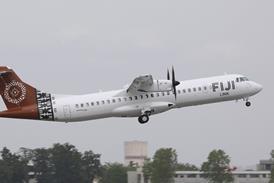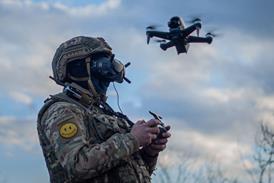Lockheed Martin has come a long way from its origins as a maker of aircraft. Over the decades, the company has broadened out into missiles, spacecraft, electronics and systems. But for much of its existence Lockheed’s fortunes, for better or for worse, have been tied to the aircraft it has produced. That is changing.

Earlier this year, Lockheed Martin changed the way it reports its financial results, gathering its electronics, systems integration and information technology businesses under a new Systems & IT group. The new group is the company’s biggest segment, its aggregated earnings for the first half of the year outstripping those of Aeronautics, previously Lockheed single biggest business sector.
Although creation of the Systems & IT group is in some ways simply a bookkeeping exercise, it underlines two important aspects of today’s Lockheed Martin. Firstly, aircraft manufacturing is no longer the company’s main activity; and secondly, systems integration and information technology are now the common themes running through the major share of the company’s business.
But Lockheed’s fortunes are still perceived by many to be linked inextricably to military aircraft manufacturing because of its high-profile products: the F-16, F/A-22 and F-35 fighters and the C-130 airlifter. The company’s aircraft programmes have attracted more than their fair share of controversy in recent years, culminating earlier this year with attempts by US Department of Defense leadership to stop procurement of the C-130J Hercules and bring an early end to production of the F/A-22 as part of efforts to cut defence spending.
Marshalling opposition within a Hercules-friendly Congress, Lockheed was able to reverse the C-130 decision on the grounds it would be too expensive to terminate the programme. But the proposal to end production of the F/A-22 Raptor after just 180 aircraft remains on the table, where it has been joined by the possibility that the F-35 Joint Strike Fighter programme could be cut back drastically. The future of the Raptor and the JSF is being decided by the Pentagon’s Quadriennel Defence Review (QDR), which is to be completed in September.
“We understand there are pressures on the US government in terms of expenditure in the Middle East, and some tough choices have to be made, but we firmly believe that the programmes that are not in good health are the ones at greatest risk,” says Lockheed Martin Aeronautics’ president Ralph Heath. “I can tell you with complete confidence that all of our programmes are performing well.”
Developed as a private venture at a cost to Lockheed of $1 billion, and sold to the US military as a commercial product, the C-130J has been a magnet for controversy from the outset. But the company believes the tide of opinion is turning in favour of the improved Hercules as it demonstrates its performance in service. “It is being operated in the Middle East theatre and demonstrating its improved capabilities in terms of speed, cost of operation, payload and versatility,” says Heath.
Earlier this year the DoD moved to terminate the six-year, $4 billion contract to produce 60 aircraft: 40 C-130J airlifters for the US Air Force and 20 KC-130J tanker/transports for the US Marine Corps. When the contract was signed in March 2003, Lockheed said multi-year procurement would save the DoD more than $500 million and secure C-130J production.
Although the termination decision has been overturned, there are still challenges ahead for the C-130J. The programme’s status as a non-tradition commercial procurement has attracted criticism and, in the aftermath its abortive attempt to lease KC-767 tankers from Boeing, the US Air Force was ordered by Congress to convert the multi-year procurement to a conventional government contract. This is not as simple as its sounds, and is not yet a done deal.
Successfully converting the contract will secure the programme, but not guarantee that procurement will continue beyond the end of the multi-year buy in 2008. despite the hundreds of older C-130s still in service. Already the US Air Force, based on its Iraq experience, is looking at the need for a smaller tactical transport, while Boeing is working to improve the short-field capability of its C-17 so that the larger transport can perform some of the intra-theatre airlift mission now performed by the C-130.
But securing the multi-year programme will keep production of the C-130J stable, allowing Lockheed to work on reducing the aircraft’s cost, which is crucial to the export market. “We now have a focused effort on driving down the cost of manufacture, and we will continue to drive it down,” says Heath, adding: “I can see the international market opening up in three to four years time.”
While Lockheed moved quickly and publicly to counter the threat to the C-130J, it has been less visibly active in defending the F/A-22. One reason is that procurement of the stealth fighter would continue to 2008 under the DoD’s proposal. Another is that the entire US tactical fighter plan is under review by a special “air dominance” panel formed for the QDR, which will shape US defence spending beginning in 2008.
The issue with the F/A-22 has always been cost, and not capability. Earlier this year the Raptor was declared operationally effective and, while there are reliability and maintainability issues to be resolved, the fighter is still scheduled to be declared operational in December. And while the proposal to stop production at 179 - rather than the 277 planned or the 321 required by the USAF – remains in play, Lockheed keeps on building aircraft. “We have continued to make outstanding progress in reducing the cost of the F/A-22 as we have ramped up production,” says Heath.
The F/A-22 also has a key role in paving the way for the F-35, which as planned will be the DoD’s largest procurement programme and Lockheed’s biggest single source of revenue within a decade. The sheer scale of the JSF programme, with 2,600 aircraft planned for the US Air Force, Navy and Marine Corps, makes it a likely target for budget cutters. Unconfirmed reports suggest options being considered under the QDR range from reducing procurement to cancelling one of the three F-35 variants.
Cancelling development of the baseline F-35A variant to make short-term savings, unlikely as it sounds, would have the greatest long-term effect on Lockheed. This is the version required by the US Air Force and most of the international partners in the JSF programme. It is also the natural follow-on Lockheed’s F-16, more than 4,000 of which have been produced for 24 countries.
Delays to the JSF have already opened a gap between the end of F-16 production in 2008 and the start of F-35 deliveries in 2012 – but they have also created an opportunity to sell more F-16s. “We can see another 100-200 orders on the international market,” says Heath. “Pakistan has been disclosed, and we have every expectation it will conclude in a significant order. Greece has said it would order 30 more F-16s. There has also been some preliminary interest in India.”
But Lockheed’s future does not rest entirely on these “traditional” aircraft programmes. Within Aeronautics, the Skunk Works is maturing technologies for unmanned aircraft, although the company has yet to win a major programme. “We are preparing ourselves,” says Heath. “A lot of what we are doing is classified and propriety. When the market really emerges, we will be there.”
Lockheed is also the prime contractor on several aircraft programmes for which is does not produce the platform. Examples include the US Navy’s MH-60S multi-mission helicopter, the VH-71A presidential helicopter and the US Army/Navy Aerial Common Sensor programme. Programmes like these, in which the company’s role is system integration, are expected to account for an increasing portion of Lockheed’s business.
Improving the links between its traditional aircraft and growing system integration and information technology businesses has become a focus for Lockheed’s leadership. “[Chief executive] Bob Stevens has instituted the concept of horizontal integration: how we can connect our expertise across all our business areas,” says Heath. “Almost every programme now has three or more of our business areas engaged. The manifestation is the F-35, which will operate in a net-centric environment.”
The changes within Lockheed are most evident in the company’s new Center for Innovation, created as a focus for collaboration between business units on the development of network-centric systems. It is here that engineers work on ways to connect the F/A-22 and F-35 with missiles, sensors, spacecraft, helicopters, and command and control systems from across the company in ways that will meet evolving defence and security requirements.
The Center for Innovation is the hub of a virtual engineering environment that connects nodes across Lockheed – soon to include the company’s UK arm – and which is designed to connect the company to its customers and industrial partners. “All of our customers are now demanding high levels of integration and command and control. We have to be responsive to these requirements,” says Heath. This is likely to accelerate Lockheed’s evolution from its origins as an aircraft maker.
MURDO MORRISON/LONDON & GRAHAM WARWICK/WASHINGTON DC
Source: Flight International























